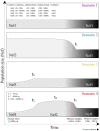Andean and California condors possess dissimilar genetic composition but exhibit similar demographic histories
- PMID: 33304512
- PMCID: PMC7713948
- DOI: 10.1002/ece3.6887
Andean and California condors possess dissimilar genetic composition but exhibit similar demographic histories
Abstract
While genetic diversity of threatened species is a major concern of conservation biologists, historic patterns of genetic variation are often unknown. A powerful approach to assess patterns and processes of genetic erosion is via ancient DNA techniques. Herein, we analyzed mtDNA from historical samples (1800s to present) of Andean Condors (Vultur gryphus) to investigate whether contemporary low genetic variability is the result of recent human expansion and persecution, and compared this genetic history to that of California condors (Gymnogyps californianus).We then explored historic demographies for both species via coalescent simulations. We found that Andean condors have lost at least 17% of their genetic variation in the early 20th century. Unlike California condors, however, low mtDNA diversity in the Andean condor was mostly ancient, before European arrival. However, we found that both condor species shared similar demographies in that population bottlenecks were recent and co-occurred with the introduction of livestock to the Americas and the global collapse of marine mammals. Given the combined information on genetic and demographic processes, we suggest that the protection of key habitats should be targeted for conserving extant genetic diversity and facilitate the natural recolonization of lost territories, while nuclear genomic data should be used to inform translocation plans.
Keywords: ancient DNA; bottleneck; genetic diversity; museum; scavenger; vulture.
© 2020 The Authors. Ecology and Evolution published by John Wiley & Sons Ltd.
Conflict of interest statement
The authors declare that they have no known competing financial interests or personal relationships that could have appeared to influence the work reported in this paper.
Figures



Similar articles
-
Chromosome-Scale Genome Assembly Provides Insights Into Condor Evolution and Conservation.Mol Ecol Resour. 2025 Oct;25(7):e70000. doi: 10.1111/1755-0998.70000. Epub 2025 Jun 19. Mol Ecol Resour. 2025. PMID: 40537975
-
Genome-wide diversity in the California condor tracks its prehistoric abundance and decline.Curr Biol. 2021 Jul 12;31(13):2939-2946.e5. doi: 10.1016/j.cub.2021.04.035. Epub 2021 May 13. Curr Biol. 2021. PMID: 33989525
-
Effects of the environmental conditions and seasonality on a population survey of the Andean condor Vultur gryphus in the tropical Andes.PeerJ. 2023 Jan 24;11:e14763. doi: 10.7717/peerj.14763. eCollection 2023. PeerJ. 2023. PMID: 36710865 Free PMC article.
-
Lead poisoning in captive Andean condors (Vultur gryphus).J Wildl Dis. 2006 Oct;42(4):772-9. doi: 10.7589/0090-3558-42.4.772. J Wildl Dis. 2006. PMID: 17255443
-
Lead in ammunition: a persistent threat to health and conservation.Ecohealth. 2013 Dec;10(4):455-64. doi: 10.1007/s10393-013-0896-5. Epub 2014 Jan 14. Ecohealth. 2013. PMID: 24419669 Review.
Cited by
-
Mitogenomic analysis of extant condor species provides insight into the molecular evolution of vultures.Sci Rep. 2021 Aug 24;11(1):17109. doi: 10.1038/s41598-021-96080-6. Sci Rep. 2021. PMID: 34429448 Free PMC article.
-
Millennia-old coral holobiont DNA provides insight into future adaptive trajectories.Mol Ecol. 2022 Oct;31(19):4979-4990. doi: 10.1111/mec.16642. Epub 2022 Aug 18. Mol Ecol. 2022. PMID: 35943423 Free PMC article.
References
-
- Adams, S. (1907). An experience with the South American condor. Condor, 9(2), 44–48. 10.2307/1361592 - DOI
-
- Alarcón, P. A. , & Lambertucci, S. A. (2018). Pesticides thwart condor conservation. Science, 360(6389), 612. - PubMed
-
- Astore, V. , Estrada, R. , & Jácome, N. L. (2017). Reintroduction strategy for the Andean Condor Conservation Program, Argentina. International Zoo Yearbook, 51(1), 124–136. 10.1111/izy.12140 - DOI
-
- Ballejo, F. , Plaza, P. I. , & Lambertucci, S. A. (2020). The conflict between scavenging birds and farmers: Field observations do not support people’s perceptions. Biological Conservation, 248, 108627 10.1016/j.biocon.2020.108627 - DOI
LinkOut - more resources
Full Text Sources

